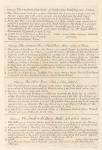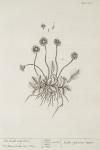

 197. The true sweet Gum Cistus of Candy. Cistus landifera vera Cretica.
197. The true sweet Gum Cistus of Candy. Cistus landifera vera Cretica.
1. This Shrub grows to be two or three Foot high, the Leaves are a grass Green, the Flowers a pale Red with a large purple spot in ye End next the Seed Vessel.
2. It grows in ye Island of Candy, & other places in ye Archipelago & flowers in Iuly.
3. From this Tree comes the Gum Labdanum of ye Shops, which some commend as good for a Looseness & Gripes, caused by sharp Humours. The Fume of it comforts the Brain, & stops catarrhous Defluxions. Outwardly applied, it is accounted strengthening to the Stomach, and stays Vomiting. See Mr. Joseph Miller's Botanicum Officinale, p. 252 & 253.
4. Greek, Κιςοη Κιθαρον, και Κιαγαρον. Latin, Cistus Ledan Cretense. Spanish, Cerguacos. Italian, Cisto. French, . German, . Dutch, Labdanum Boom.

 198. The Common Fir, or Pitch Tree. Abies rubra or Picea.
198. The Common Fir, or Pitch Tree. Abies rubra or Picea.
Also see #198. The Common Fir - #203. The male Fir
1. This grows to be a large Tree, the Leaves are a small slender & prickly, of a bright grass Green Colour, the Catkins greenish, the Cones a light Brown & ye Seed Brown.
2. It grows wild in Germany & Scotland, sending out its Catkins in the Spring.
3. The Leaves and Tops are used in Diet Drinks for the Scurvy, & are an Ingredient in the Brunswick Mum. The Strasburg Turpentine comes from this Tree, which is mollifying healing & cleansing & a great Diuretic, usefull in Wounds, Ulcers, a Gonorrhea, the Fluor albus, the Stone & Gravel, & Affections of ye Breast & Lungs. Tar is also the Product of this Tree, and is accounted a good pectoral Medicine, useful for shortness of Breath and Obstructions of the Lungs.
4. Greek, Πευκη. Latin, Picea. Spanish, Pino negro. Italian, Pezzo. French, Pesse, Pignet or Garipolt. German, Rat Zannenbaum. Dutch, Denne Boom.

 199. The Olive Tree. Olea or Olea sativa.
199. The Olive Tree. Olea or Olea sativa.
Also see #199. The Olive tree - #213. The Wild Olive Tree
1. The Tree grows to a great Bigness in its native Climate, the Leaves are a deep Green above & hoary underneath, the Flowers yellow, & the Fruit black when ripe.
2. It grows in Spain, Italy and Turky.
3. The Oil is moderately healing & mollifying, rendring the Body lax & soluble; it helps Disorders of ye Breast & Lungs, & eases Gripings & the Collic. - It is of great use against all corrosive mineral Poisons, as Arsenic, Sublimate &c. It opens ye Urinary Passages & is good for ye Stone & Gravel. The pickled Olives are grateful to ye Stomach, and provoke an Appetite. The ripe Olives are a great Part of ye Food of the Eastern Countries, among the Greeks, especially in Lent.
4. Greek, Ελαια. Latin, Olea. Spanish, Olivo or Azeytimo. Italian, Olivo. French, Olivier. German, Oelbaum. Dutch, Olyf.

 200. The small wild Daisy. Bellis sylvestris minor.
200. The small wild Daisy. Bellis sylvestris minor.
1. The Stalk grows about four Inches high, the Leaves are a light Green, the Flowers white set about a yellow Thrum, & sometimes red round ye Edges & red underneath.
2. It grows in Fields & Meadows flowring in March April and May.
3. This is accounted a traumatick & vulnerary Plant, being used in Wound Drinks; the Leaves are esteem'd good to dissolve congeal'd & coagulated Blood, yelp ye Pleurisy and Peripneumonia. Some commend a Decoction given Inwardly and a Cataplasm of ye Leaves applied outwardly as extraordinary Remedies in the King's Evil.
4. Greek, . Latin, Bellis minor. Spanish, . Italian, Fior di prima vera. French, Marguerites or Pasquette. German, Masslieben. Dutch, Maagdelieben.

